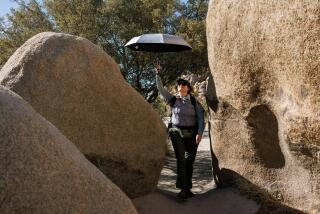Rising Heat in Desert Is Blamed for 5 July Deaths
- Share via
Five people who ventured into the San Bernardino County desert have died from heat-related complications this month in what officials are describing as a worrisome increase in such fatalities.
The county averages one or two heat-related deaths yearly, so five in one month is highly unusual, said Randy Emon, spokesman for the San Bernardino County coroner. Temperatures topping 100 degrees combined with high humidity are to blame for the rise in deaths, Emon said.
All this comes despite warnings by the National Park Service and county health officials that people should not hike in the desert when it’s extremely hot.
The badly decomposed bodies of 31-year old Sharon Eldrington of Twentynine Palms and 26-year-old Shawn Pritchard of Wonder Valley were found last week in Twentynine Palms in a remote area of the military base just outside Joshua Tree National Park. They were 20 miles from the nearest place they could have received help.
“You usually don’t find people hanging out in the training area,” said Capt. Rob Crum, public information officer at the Marine Corps Air Ground Combat Center. “It’s off limits to civilians.”
Crum said it’s not uncommon to spot trespassers on the training ground. Sometimes civilians are on the base looking for bullet casings and shrapnel.
“When people decide that they are going to go exploring in the desert, they need to make sure that they are adequately prepared,” he said.
Cindy VonHalle, supervisory park ranger at Joshua Tree National Park, warns that hiking in the desert during the summer can be deadly if people don’t carry enough water and fill their cars with gas.
Still, there are those who go off the marked trails, hiking farther from help into some of the remotest parts of the park, she said.
“There are no water sources in the park whatsoever. No spigots, no lakes, no rivers,” VonHalle said. “If you break down, there might not be any help for a day.”
The same goes for in and around the Mojave National Preserve, said park Supt. Mary Martin.
People who begin running low on gas assume there are gas stations around, but there aren’t, officials said.
Another common problem is getting stuck in the sand, as did Jim Spellmire and 18-year-old son Al on a high-desert trip in Johnson Valley, near Landers, on July 12. Al Spellmire, an Irvine resident, hiked ahead of his father for help but was later found dead.
“You can have a flat tire out there and then have an impossible time trying to jack it up in the sand,” Martin said. “You never know when you’re going to break down. You can be alone, and help can be a long way away.”
Health officials in San Bernardino and Riverside counties and park officials recommend hiking between 6 and 10 a.m. and bringing a gallon of water per day per person, umbrellas, a full tank of gas and sunscreen for desert trips. In addition, people should check whether their cell phones will get coverage before heading out.
More to Read
Sign up for Essential California
The most important California stories and recommendations in your inbox every morning.
You may occasionally receive promotional content from the Los Angeles Times.













